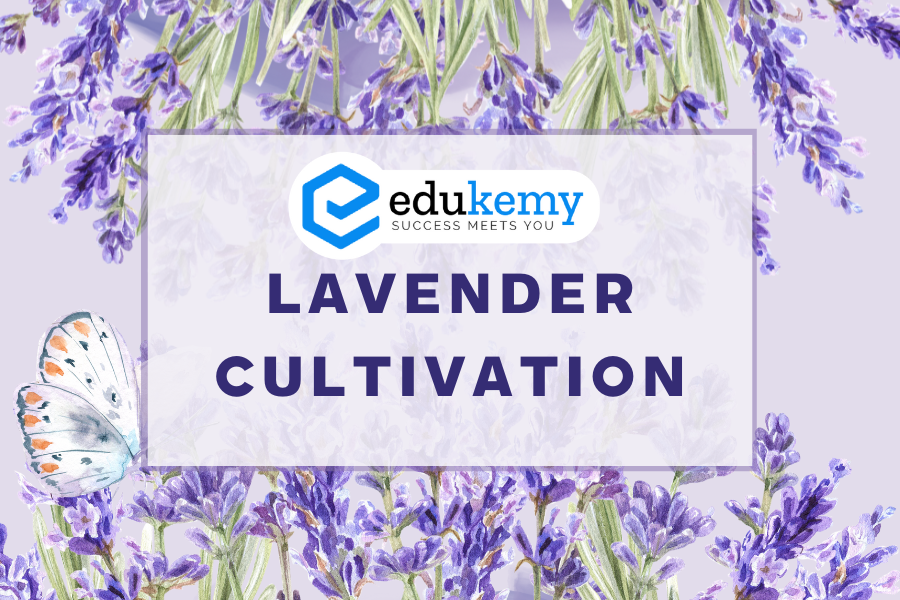
Lavender cultivation, a centuries-old practice cherished for its aromatic allure and multifaceted utility, is an art form intertwined with history, culture, and modern agriculture. Delicate yet hardy, lavender (Lavandula) thrives in a myriad of climates, gracing gardens, landscapes, and commercial fields worldwide. With its soothing fragrance and myriad of applications spanning from culinary delights to therapeutic potions, lavender has cemented its place as a beloved botanical treasure. Whether embarking on a journey of aromatic indulgence, seeking sustainable agriculture, or exploring the depths of herbal remedies, lavender cultivation beckons with promises of sensory delight and endless possibilities.
Tags: GS Paper – 3 Agricultural Marketing- Agricultural Pricing- Agricultural Resources
For Prelims: Lavender Cultivation, Lavender, Aroma Mission.
For Mains: Lavender Cultivation and its significance, Agricultural Pricing, Agricultural Resources.
Contents
Context:
- Lavender cultivation will commence in Ramban district, Jammu Kashmir, as part of the Purple Revolution under CSIR-IIIM’s Aroma Mission.
- Aromatic plants such as lavender, damask rose, and mushk bala are included in this initiative.
- CSIR is a modern R&D organisation under the Ministry of Science and Technology.
What is the Purple Revolution?
About:
- The Purple or Lavender Revolution, initiated in 2016 by the Union Ministry of Science & Technology through CSIR’s Aroma Mission, focuses on lavender cultivation across almost all 20 districts of Jammu & Kashmir. First-time farmers received free lavender saplings, while previous cultivators were charged Rs. 5-6 per sapling.
Aim:
- To bolster the domestic aromatic crop-based agro-economy by transitioning from imported to homegrown aromatic oils.
Products:
- The main product is Lavender oil, valued at Rs. 10,000 per litre. Lavender water, a by-product, is used in incense sticks, while hydrosol is utilised in soaps and room fresheners.
Significance:
- Aligned with the government’s goal of doubling farm incomes by 2022, the Purple Revolution supports budding farmers, agri-entrepreneurs, and the Start-Up India campaign. Over 500 youth have benefited, significantly augmenting their incomes.
What is an Aroma Mission?
About:
- The CSIR Aroma Mission aims to transform the aroma sector by intervening in agriculture, processing, and product development, fueling industry growth and rural employment. It promotes the cultivation of aromatic crops for essential oils, aspiring for global leadership akin to menthol mint production.
Aroma Mission Phase-I and II:
- Phase-I cultivated 6000 hectares across 46 aspirational districts, training over 44,000 individuals. Phase-II, launched on 9th February 2021, targets over 45,000 skilled personnel, benefiting 75,000 farming families nationwide.
Nodal Agencies:
- The CSIR-Central Institute of Medicinal and Aromatic Plants (CSIR-CIMAP), Lucknow, serves as the nodal laboratory.
Intended Outcomes:
- To bring 5500 hectares under captive cultivation of aromatic cash crops, especially on rain-fed/degraded lands.
- The mission provides technical support, infrastructure, and buy-back mechanisms, adding value to essential oils and aroma ingredients for global trade integration.
FAQs
Q: What are the ideal growing conditions for lavender?
Lavender thrives in well-drained soil with full sunlight exposure. It prefers slightly alkaline soil with a pH between 6.7 and 7.3. Mediterranean-like climates with dry summers and mild winters are perfect for lavender cultivation.
Q: How do I propagate lavender plants?
Lavender can be propagated through seeds, cuttings, or layering. However, the most common method is propagation through cuttings. Take 4-6 inch cuttings from healthy, non-flowering stems in spring or early summer. Remove the lower leaves, dip the cut end in rooting hormone, and plant in well-draining soil.
Q: How often should lavender be watered?
Lavender is drought-tolerant once established and prefers dry conditions. Water newly planted lavender regularly to help establish roots, but once established, water sparingly. Overwatering can lead to root rot. Water deeply but infrequently, allowing the soil to dry out between watering sessions.
Q: When and how should lavender be pruned?
Lavender should be pruned in the spring to promote new growth and maintain shape. After the last frost, trim back the plant by about one-third, cutting just above where green growth begins. Regular pruning helps prevent the plant from becoming woody and encourages better flowering.
Q: What are common pests and diseases affecting lavender?
Lavender is relatively pest and disease resistant, but it can still be susceptible to certain issues. Common pests include aphids, spider mites, and root rot caused by overly wet conditions. Diseases such as lavender fungal diseases and gray mold can occur in overly humid environments. Proper spacing, good air circulation, and avoiding overhead watering can help prevent these problems.
In case you still have your doubts, contact us on 9811333901.
For UPSC Prelims Resources, Click here
For Daily Updates and Study Material:
Join our Telegram Channel – Edukemy for IAS
- 1. Learn through Videos – here
- 2. Be Exam Ready by Practicing Daily MCQs – here
- 3. Daily Newsletter – Get all your Current Affairs Covered – here
- 4. Mains Answer Writing Practice – here

